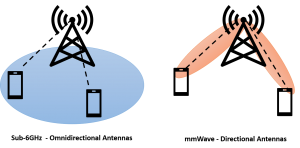Published on: Nov 13, 2020
Welcome to Part 2 of our MINTS 101 series where we explain the MINTS project! In Part 1 — mmWaves, we introduced our project and mmWave technology. In Part 2, we will explain what is new and so exciting about mmWave technology and why we need it for wireless communications.
What exactly is Sub-6 GHz?
When we talk about Sub-6 GHz technologies, we mean the majority of commercial wireless technologies available today. That means your WiFi at home, the 3G/4G/5G cellular connections on your smartphone, the Bluetooth that your wireless headphones use, and almost anything else you can think of. We use this term since all these technologies currently operate on frequencies below 6 GHz, in contrast to mmWave technology which proposes using frequencies between 30 – 300 GHz for communication.
This is important because electromagnetic waves of different frequencies have very different properties, as seen in Figure 1, which shows the electromagnetic spectrum. Increasing the frequency separates the visible light spectrum (red light has the lowest frequency and blue light the highest frequency) from ultraviolet waves (emitted by the sun) or X-Rays (used in medicine, security, among other applications). We use the lower/radio frequencies for wireless communication and so far the majority of commercial wireless networks use the frequencies between 800 MHz and 6 GHz, i.e., Sub-6 GHz.
Why is this Sub-6 GHz band so particular? Well, it has properties that make it the most suitable for wireless communication, i.e., it is not harmful to humans, it has good propagation properties (meaning that the signals travel over long distances without deterioration), and it has a large amount of bandwidth available.

Figure 1: The electromagnetic spectrum.
The amount of bandwidth available is a measure for the capacity of the communication channel. The standard WiFi channels, for example, have a bandwidth of 20 MHz, with newer WiFi devices expanding them up to 160 MHz [1]. By increasing the bandwidth of the channel, we can increase the data transmission speed, similar to how increasing the size of a pipe allows for more water to flow through it at the same time. Alternatively, we can look at bandwidth from a system perspective – having more bandwidth in a network allows it to have more channels and serve more users simultaneously. To have an effective communication system, both of these conditions need to be satisfied – the network needs to have enough channels to handle lots of users, and each channel needs to be large enough to provide satisfactory data transmission speed to the user. The frequency bands lower than 800 MHz have limited bandwidth that cannot satisfy current network requirements. That’s why they’re only used for AM/FM radio transmissions.
Explaining the propagation characteristics is a bit more complicated, but one key aspect is connected to the strength of signals. All electromagnetic signals weaken as they travel across space. If the signal gets too weak, communication is no longer possible. Try to think of what happens when you leave your house – the WiFi signal gets weaker, and eventually, you can no longer connect to it. This attenuation is proportional to the frequency of the signal, meaning that the higher the frequency of the signal, the faster it weakens. Therefore, using very high frequencies is not convenient as we can only communicate at short distances, which is not very practical.
Therefore, for communication purposes, we use the portion of the spectrum that has enough bandwidth and does not suffer significant degradation over large distances, leading us to the bands between 800 MHz and 6 GHz.
So, what’s the problem then?
The problem is that the amount of traffic in wireless systems has been increasing exponentially for the last decade with no signs of slowing down. Figure 2 shows this increase in mobile data traffic. Think about how much more time we spend on the Internet compared to ten years ago, and how the number of devices that we use simultaneously has increased. Also, think about how the Internet usage has changed – from communicating mostly by chat and watching low-quality videos to streaming full HD movies on smart TVs and having 20 person video conference calls. The current networks are becoming overloaded and unable to meet users’ demand. Since March this year, as millions of people have started working and studying from home due to COVID-19, the global network infrastructure has been straining under the pressure. Netflix and YouTube were even forced to temporarily reduce the video streaming quality in Europe to avoid network crashes [2].

Figure 2: The growth of global mobile data traffic.
The vision for the world of tomorrow will demand even more from wireless networks [3]. Think about artificial and virtual reality, holograms, self-driving cars, and smart homes. Imagine the possibility of telemedicine and remote surgery and the fourth industrial revolution triggered by automation. Thinking about this in 2020 as we see the world change in front of our eyes, it is impossible not to consider the possible impact of these changes. Automated factories can mean less essential workers packed in crowded spaces and forced to risk their lives. Virtual reality can give children a chance to learn and socialize in virtual classrooms. Telemedicine can help reduce the risk for both the medical workers and the patients. Now, more than ever, we can see how a better-connected world leads to a better life for everyone.
Current networks do not have enough bandwidth to support this. Moreover, we are running out of spectrum for deploying new technologies. Every time a new system, for example, 5G, is put into service we need to assign it a part of the spectrum where it can run in order to not interfere with other systems (like 4G and WiFi) that are already operational. The part of the spectrum that we are currently using is getting overcrowded and soon, it will be difficult to find space to deploy new technologies.
This is where mmWave comes in. The higher frequency bands have plenty of unused spectrum available and huge amounts of bandwidth. The total amount of bandwidth we are currently using for wireless communication is approximately 5.2 GHz, and there is 270 GHz free in the higher mmWave bands. It is true that currently, most research is focused on frequencies up to 60 GHz, but that is still approximately 5 times more than the current spectrum in use. Do you remember the WiFi channels in Sub-6 GHz that had a bandwidth between 20-160 MHz? New standards for WiFi that use mmWave technology have channels with the size of 2.16 GHz and aggregation can go with up to 8.64 GHz [4]. This means that your Sub-6 GHz WiFi router at home can probably achieve a data transmission speed up to around 100 Mbps, while the lowest speed with mmWave WiFi is 350 Mbps. mmWave will allow for multi-Gbps connectivity – up to a maximum of 100 Gbps, bringing with it not only a possible solution for our current problems but also plenty of possibilities for the future of wireless networks.
When can I have my ultra-fast mmWave Internet ready?
Before we can get to that part, there are still many issues we have to solve. After all, there is a reason why we are just starting to consider using these frequencies for communication. Remember the part about signal attenuation? When we consider mmWave frequencies, attenuation becomes a big problem, reducing the range at which we can communicate to a few meters and making it difficult for mmWaves to penetrate walls or obstacles. Your WiFi router wouldn’t be much good if you can only connect to it if you’re standing very close.
In order to overcome the increased attenuation and extend the communication range it will be necessary to use directional antennas. This means instead of transmitting the signal in all directions (omnidirectionally), which is how it is currently transmitted, we focus the energy solely in the direction of our receiver. Figure 3 shows a comparison between directional and omnidirectional communication. Using directional antennas will be crucial to enabling mmWave communication, however, it also introduces a lot of challenges. This includes the need to determine the direction of transmission and then continuously adapt it according to the receiver’s movement. Furthermore, mmWave is much more sensitive to obstacles and changes in the environment, meaning that a person passing between you and the router can break your connection. Additionally, due to all these significant differences in propagation, the traditional radio wave channel models we currently use do not apply to mmWave channels. All of this means that communication at mmWave is fundamentally different than at Sub-6 GHz, and it requires us to adapt our systems in many aspects.

Figure 3: Comparison of omnidirectional and directional antennas.
Fortunately, researchers have already proposed many solutions to these problems. In our MINTS project, we will work on some of the remaining issues in order to facilitate the daily use of mmWave technology. Part of our research will focus on dealing with dynamic, complex environments and crowded areas (large office buildings or shopping malls). Additionally, we will study new, innovative applications and explore the full potential of mmWave. In our future blogs, we will give you more details about the challenges that we will tackle in MINTS, but for now we hope we’ve explained to you what is new about mmWave and convinced you that it is a promising technology for our future!
If you could stick with us until the end and can’t wait for more content and you also want to know more about us and our MINTS project, you can always follow our social media channels.
Citations
[1] “IEEE Standard for Information technology—Telecommunications and information exchange between systems Local and metropolitan area networks—Specific requirements – Part 11: Wireless LAN Medium Access Control (MAC) and Physical Layer (PHY) Specifications,” in IEEE Std 802.11-2016 (Revision of IEEE Std 802.11-2012) , vol., no., pp.1-3534, 14 Dec. 2016, doi: 10.1109/IEEESTD.2016.7786995.
[2] https://www.bbc.com/news/technology-51968302
[3] https://futurenetworks.ieee.org/roadmap/perspectives-on-5g-applications-and-services
[4] Y. Ghasempour, C. R. C. M. da Silva, C. Cordeiro and E. W. Knightly, “IEEE 802.11ay: Next-Generation 60 GHz Communication for 100 Gb/s Wi-Fi,” in IEEE Communications Magazine, vol. 55, no. 12, pp. 186-192, Dec. 2017, doi: 10.1109/MCOM.2017.1700393.





